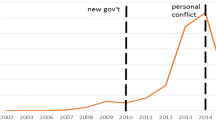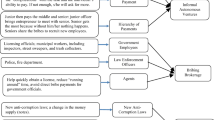Abstract
This article presents a comprehensive theoretical approach to the study of procurement corruption. It argues that corruption in public procurement can be explained by the creation and development of “corrupt procurement coalitions” (CPCs). Functioning as a network built by corruption entrepreneurs seeking to “milk” the procurement process, a CPC must accomplish three interrelated tasks to succeed: 1) identifying which members to include and organizing interactions of said members, 2) generating and redistributing benefits, and 3) evading internal and external control. CPCs are structured in an inner/peripheral configuration, where the inner network controls the core activities, and the peripheral networks can be activated at will when illegal tasks need to be externalized.



Similar content being viewed by others
Notes
The Commission was created in 2011 by the government of Quebec after two years of media allegations of widespread corruption in public procurement at the municipal and provincial level. Its mandate was to examine public works contracts awarded by municipalities and provincial departments and to unveil schemes of corruption and collusion. The Commission was also explicitly mandated to explore the possibility that corruption schemes might be related to illegal party financing and to inquire into the possible presence of organized crime in the construction industry. Its mandate covers a fifteen-year period from 1996 to 2011.
Almost all illustrations used in this article are based on testimonies given under oath to the Commission. Others sources (journalistic, for example) are duly mentioned. Nevertheless, we feel it is important to remind our readers that the people involved in these allegations have not been found guilty by a court of law and should therefore be considered innocent until proven otherwise.
References
Association for Project Management. 2011. About Us. Accessed June 13. http://www.apmqa.co.uk/ContractProcurement/page.asp?categoryID=9&subCategoryID=146&pageID=0.
Bernier, L., & Hafsi, T. (2007). The Changing Nature of Public Entrepreneurship. Public Administration Review, 67(3), 488–503. doi:10.1111/j.1540-6210.2007.00731.x.
Bisson, Bruno. 2012. Le parrain Vito Rizzuto, médiateur de conflit? La Presse, October 2. http://www.lapresse.ca/actualites/dossiers/commission-charbonneau/201210/02/01-4579409-le-parrain-vito-rizzuto-mediateur-de-conflit.php.
Blais, Annabelle. 2012. L’intimidation a Eu Raison de L’éthique de Michel Leclerc. Métro, November 19. http://journalmetro.com/dossiers/la-commission-charbonneau/191989/un-entrepreneur-cede-a-lintimidation/.
Boulton, David. 1978. The Grease Machine. Harper & Row.
Burguet, R., & Che, Y.-K. (2004). Competitive Procurement with Corruption. The RAND Journal of Economics, 35(1), 50–68.
Cartier-Bresson, J. (1997). Corruption Networks, Transaction Security and Illegal Social Exchange. Political Studies, 45(3), 463–495.
CEIC. 2012. Testimony of Lino Zambito. Montréal. https://www.ceic.gouv.qc.ca/fileadmin/Fichiers_client/fichiers/Transcriptions/2012-10/Transcription_audience_CEIC_2012-10-01.pdf.
CEIC. 2013a. Testimony of Serge Pourreaux. Montréal. https://www.ceic.gouv.qc.ca/fileadmin/Fichiers_client/fichiers/Transcriptions/2013-02/Transcription_audience_CEIC_2013-02-28.pdf.
CEIC. 2013b. Testimony of Michel Lalonde. Montréal. https://www.ceic.gouv.qc.ca/fileadmin/Fichiers_client/fichiers/Transcriptions/2013-01/Transcription_audience_CEIC_2013-01-24.pdf.
CEIC. 2013c. Testimony of Rosaire Sauriol. Montréal. https://www.ceic.gouv.qc.ca/fileadmin/Fichiers_client/fichiers/Transcriptions/2013-03/Transcription_audience_CEIC_2013-03-20.pdf.
CEIC. 2013d. Testimony of Bernard Trépanier. Montréal. https://www.ceic.gouv.qc.ca/fileadmin/Fichiers_client/fichiers/Transcriptions/2013-03/Transcription_audience_CEIC_2013-03-26_diffusee.pdf.
CEIC. 2014. Testimony of Tony Accurso. Montréal. https://www.ceic.gouv.qc.ca/fileadmin/Fichiers_client/fichiers/Transcriptions/2014-09/Transcription_audience_CEIC_2014-09-05_diffusee.pdf.
Choi, J.-W. (2007). Governance Structure and Administrative Corruption in Japan: An Organizational Network Approach. Public Administration Review, 67(5), 930–942.
Clinard, M., & Yeager, P. (1980). Corporate Crime. New York: Free Press.
Compte, O., Lambert-Mogiliansky, A., & Verdier, T. (2005). Corruption and competition in procurement auctions. The Rand Journal of Economics, 36(1), 1–15.
Cyert, R., & March, J. G. (1963). A Behavioral Theory of the Firm. NJ: Prentice-Hall. Englewood Cliffs.
De Graaf, G., & Huberts, L. W. J. C. (2008). Portraying the Nature of Corruption Using an Explorative Case Study Design. Public Administration Review, 68(4), 640–653.
Della Porta, D., & Vannucci, A. (1999). Corrupt Exchanges: Actors, Resources, and Mechanisms of Political Corruption. New York: Aldine Transaction.
Della Porta, D., & Vannucci, A. (2013). The Hidden Order of Corruption: An Institutional Approach. Ashgate.
Gamson, W. A. (1961). A Theory of Coalition Formation. American Sociological Review, 26(3), 373–382.
Gottschalk, P. (2009). Entrepreneurship and Organised Crime: Entrepreneurs in Illegal Business. Cheltenham: Edward Elgar.
Gottschalk, P. (2010). Entrepreneurship in Organised Crime. International Journal of Entrepreneurship and Small Business, 9(3), 295–307.
Granovetter, M. (1985). Economic Action and Social Structure: The Problem of Embeddedness. American Journal of Sociology, 91(3), 481–510.
Jancsics, D., & Jávor, I. (2012). Corrupt Governmental Networks. International Public Management Journal, 15(1), 62–99.
Jávor, István, and David Jancsics. 2013. The Role of Power in Organizational Corruption: An Empirical Study. Administration & Society, December. http://aas.sagepub.com/content/early/2013/12/10/0095399713514845.
Klitgaard, R. (1988). Controlling Corruption. Berkeley: University of California Press.
Lambsdorff, J. G. (2002). Making Corrupt Deals: Contracting in the Shadow of the Law. Journal of Economic Behavior & Organization, 48(3), 221–241. doi:10.1016/S0167-2681(01)00217-7.
Langlois, R. N. (2007). The Entrepreneurial Theory of the Firm and the Theory of the Entrepreneurial Firm. Journal of Management Studies, 44(7), 1107–1124.
La Presse canadienne. 2013a. Commission Charbonneau: Théberge Explique Le Fonctionnement Du Cartel de L’asphalte. Le Devoir. mai. http://www.ledevoir.com/politique/quebec/378860/commission-charbonneau-theberge-explique-le-fonctionnement-du-cartel-de-l-asphalte.
La Presse canadienne. 2013b. Commission Charbonneau – C’était «honteux et Dégradant», Dit Le Président de BPR Sur Le 3 % À Verser. Le Devoir, March 18. http://www.ledevoir.com/politique/quebec/373524/commission-charbonneau-c-etait-honteux-et-degradant-dit-le-president-de-bpr-sur-le-3-a-verser.
Lemieux, V. (1997). Réseaux et Coalitions. L’Année Sociologique, Troisième série, 47(1), 55–71.
Lemieux, V. (1998). Les Coalitions. Liens, Transactions et Contrôles. Paris: PUF.
Lévesque, Kathleen. 2012. Commission Charbonneau - La Corruption, Une «culture D’entreprise».” Le Devoir, November 2. http://www.ledevoir.com/societe/justice/363009/la-corruption-une-culture-d-entreprise.
Milward, H. B., & Raab, J. (2006). Dark Networks as Organizational Problems: Elements of a Theory. International Public Management Journal, 9(3), 333–360.
Ministério público federal do Brasil. 2014. Denúncia no caso 'Lava-Jato'. Curitiba. http://lavajato.mpf.mp.br/atuacao-na-1a-instancia/denuncias-do-mpf/documentos/arquivo-18-denuncia
Moody-Stuart, G. (1997). How Business Bribes Damage Developing Countries. UK: Word View Publishing.
Myles, Brian. 2013a. Commission Charbonneau – Zampino a Torpillé La Lutte À La Collusion. Le Devoir. March 1. http://www.ledevoir.com/politique/quebec/372244/zampino-a-torpille-la-lutte-a-la-collusion.
Myles, Brian. 2013b. Commission Charbonneau - Le Stratagème de Génivar Décodé Par Perreault. Le Devoir, March 13. http://www.ledevoir.com/politique/quebec/373127/commission-charbonneau-dix-sept-fausses-factures-decouvertes-chez-genivar.
Myles, Brian. 2013c. Commission Charbonneau – Confessions Laborieuses de Bernard Trépanier. Le Devoir. March 27. http://www.ledevoir.com/politique/quebec/374278/commission-charbonneau-confessions-laborieuses-de-bernard-trepanier.
Normandin, Pierre-André. 2012a. Contrats municipaux: un logiciel controversé toujours utilisé. La Presse. http://www.lapresse.ca/actualites/montreal/201212/11/01-4602730-contrats-municipaux-un-logiciel-controverse-toujours-utilise.php.
Normandin, Pierre-André. 2012b. Luc Leclerc aurait reçu au moins 500 000$. La Presse, October 31. http://www.lapresse.ca/actualites/dossiers/commission-charbonneau/201210/31/01-4588957-luc-leclerc-aurait-recu-au-moins-500-000.php.
Normandin, Pierre-André. 2013. Collusion: Michel Lalonde, le chef d’orchestre. La Presse, January 25. http://www.lapresse.ca/actualites/dossiers/commission-charbonneau/201301/24/01-4614873-collusion-michel-lalonde-le-chef-dorchestre.php.
O’Toole Jr., L. J. (1997). Treating Networks Seriously: Practical and Research-Based Agendas in Public Administration. Public Administration Review, 57(1), 45–52.
Ouchi, W. G. (1980). Markets, Bureaucracies, and Clans. Administrative Science Quarterly, 25(1), 129–141.
Pfeffer, J., & Salancik, G. R. (2003). The External Control of Organizations: A Resource Dependence Perspective. Redwood City: Stanford University Press.
Provan, K. G., & Kenis, P. (2008). Modes of Network Governance: Structure, Management, and Effectiveness. Journal of Public Administration Research and Theory, 18(2), 229–252.
Raab, J., & Milward, H. B. (2003). Dark Networks as Problems. Journal of Public Administration Research and Theory, 13(4), 413–439. doi:10.1093/jpart/mug029.
Roman, A. V. (2014). The Politics of Bounded Procurement: Purists, Brokers and the Politics-Procurement Dichotomy. Journal of Public Procurement, 14(1), 33–61.
Sabatier, P., & Jenkins-Smith, H. C. (1993). Policy Change and Learning: An Advocacy Coalition Approach. Boulder: Westview Press.
Schapper, P. R., Malta, J. N. V., & Gilbert, D. L. (2006). An Analytical Framework for the Management and Reform of Public Procurement. Journal of Public Procurement, 6(1/2), 1–26.
Schofield, N. (1995). Coalition Politics: A Formal Model and Empirical Analysis. Journal of Theoretical Politics, 7(3), 245–281.
Shane, S., & Venkataraman, S. (2000). The Promise of Entrepreneurship as a Field of Research. The Academy of Management Review, 25(1), 217–226.
Sherman, L. W. (1980). Three Models of Organizational Corruption in Agencies of Social Control. Social Problems, 27(4), 478–491. doi:10.2307/800176.
Søreide, T. (2002). Corruption in Public Procurement: Causes, Consequences and Cures . Bergen: Chr. Michelsen Institute.R 2002: 1
Stevenson, W. B., Pearce, J. L., & Porter, L. W. (1985). The Concept of ‘Coalition’ in Organization Theory and Research. Academy of Management Review, 10(2), 256–268.
Symeonidou-Kastanidou, E. (2007). Towards a New Definition of Organised Crime in the European Union. European Journal of Crime, Criminal Law and Criminal Justice, 15(1), 83–103.
Thai, K. V. (2001). Public Procurement Re-Examined. Journal of Public Procurement, 1(1), 9–50.
Den Heuvel, V., & Grat (2006). The Parliamentary Enquiry on Fraud in the Dutch Construction Industry Collusion as Concept Between Corruption and State-Corporate Crime. Crime, Law and Social Change, 44(2), 133–151.
Von Lampe, K. 2007. Criminals Are Not Alone. Some Observations of the Social Microcosm of the Illegal Entrepreneurs. In Crime Business and Crime Money in Europe. The Dirty Linen of Illegal Entreprise, edited by P. C. van Duyne, A. Majevic, M. van Dijck, K. von Lampe, and J. Harvey, Wolf Legal Publishers: Nijmegen 131–56.
Williamson, O. E. (1975). Markets and Hierarchies, Analysis and Antitrust Implications: A Study in the Economics of Internal Organization. New York: Free Press.
Yin, R. K. (2009). Case Study Research: Design and Methods (Fourth ed.). Thousand Oaks: Sage Publications.
Zander, I. (2007). Do You See What I Mean? An Entrepreneurship Perspective on the Nature and Boundaries of the Firm. Journal of Management Studies, 44(7), 1141–1164.
Author information
Authors and Affiliations
Corresponding author
Ethics declarations
Funding
Pierre-André Hudon received a Postdoctoral Fellowship from the Social Sciences and Humanities Research Council (SSHRC) of Canada. The authors would like to thank the SSHRC for making this research possible.
Rights and permissions
About this article
Cite this article
Hudon, PA., Garzón, C. Corruption in public procurement: entrepreneurial coalition building. Crime Law Soc Change 66, 291–311 (2016). https://doi.org/10.1007/s10611-016-9628-4
Published:
Issue Date:
DOI: https://doi.org/10.1007/s10611-016-9628-4




